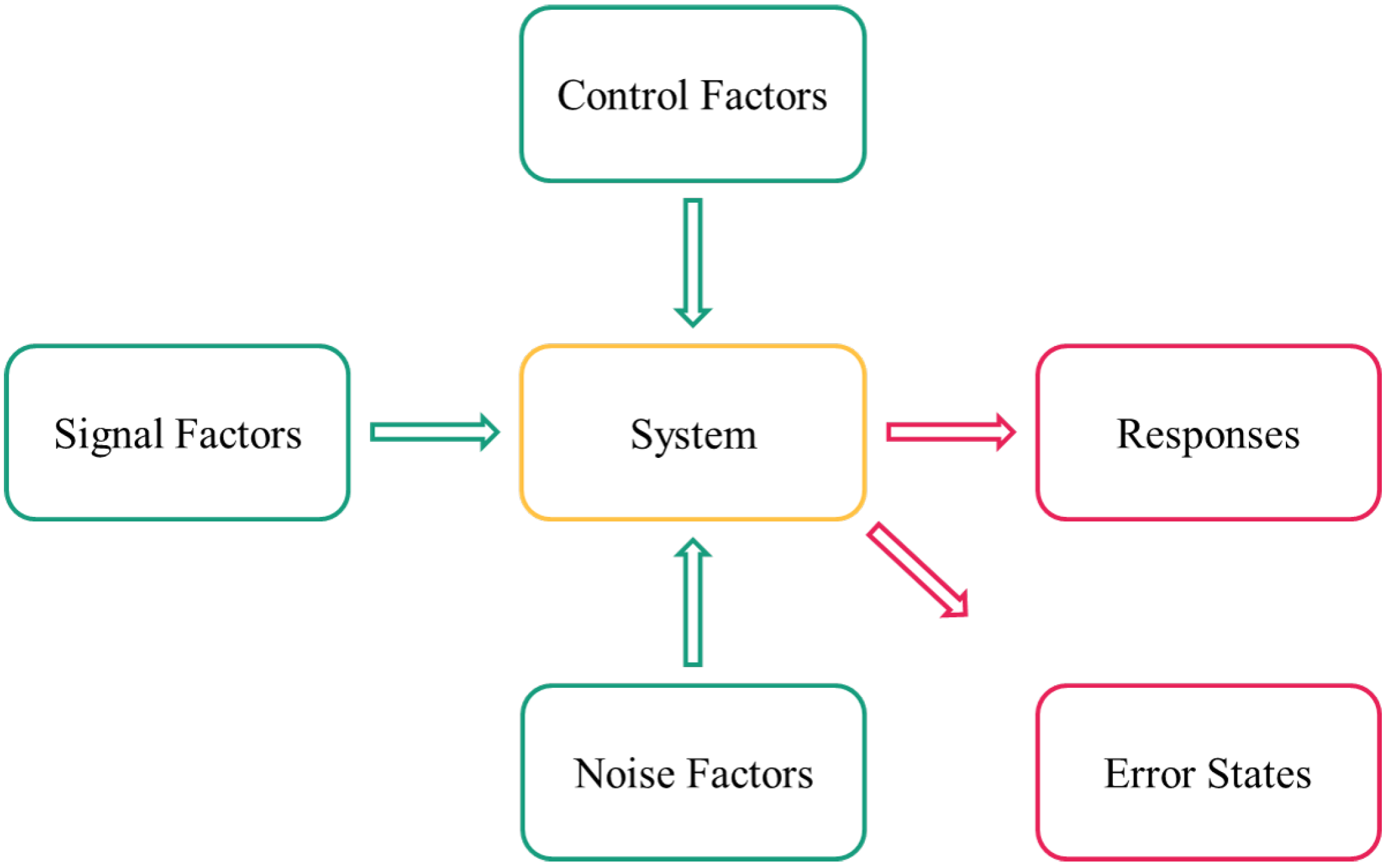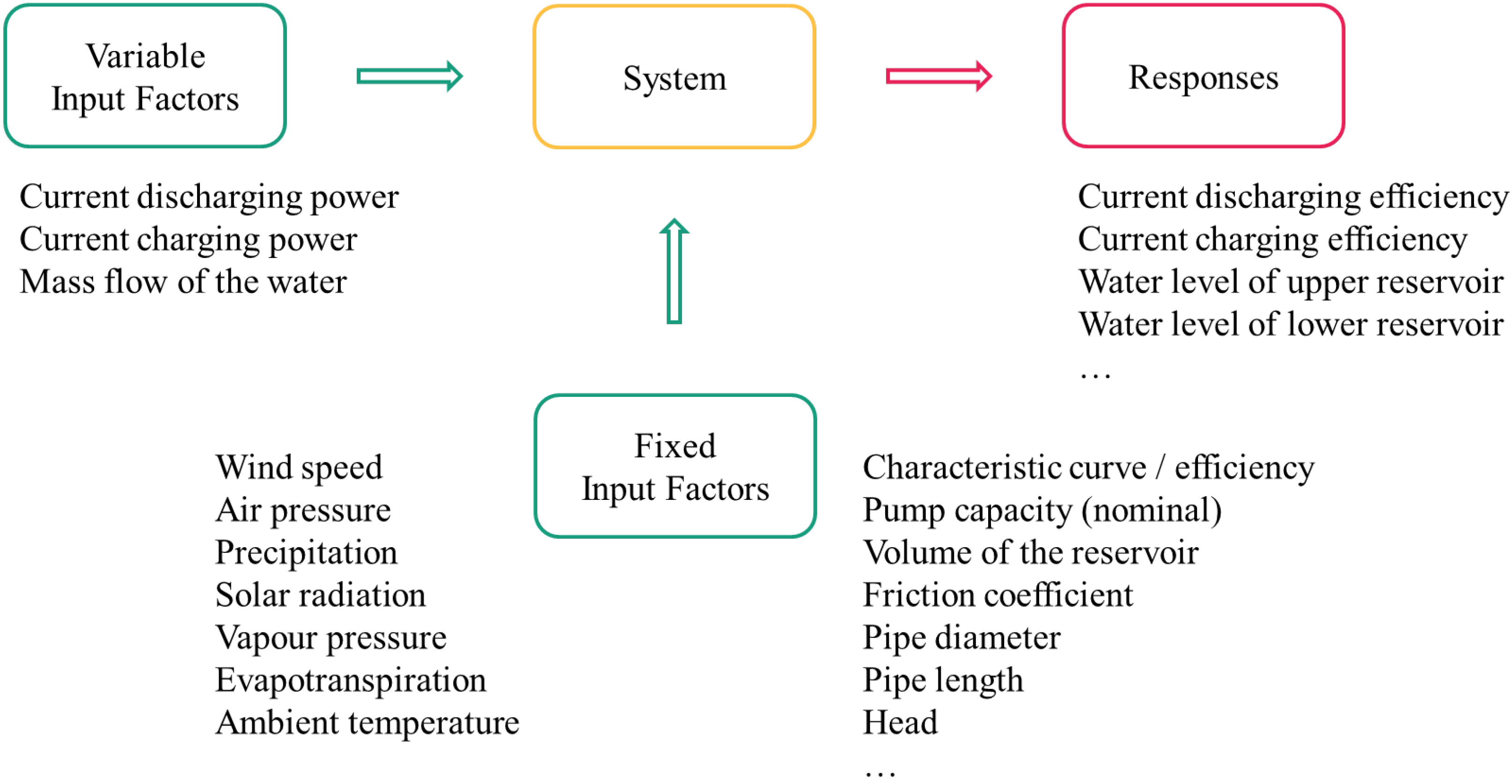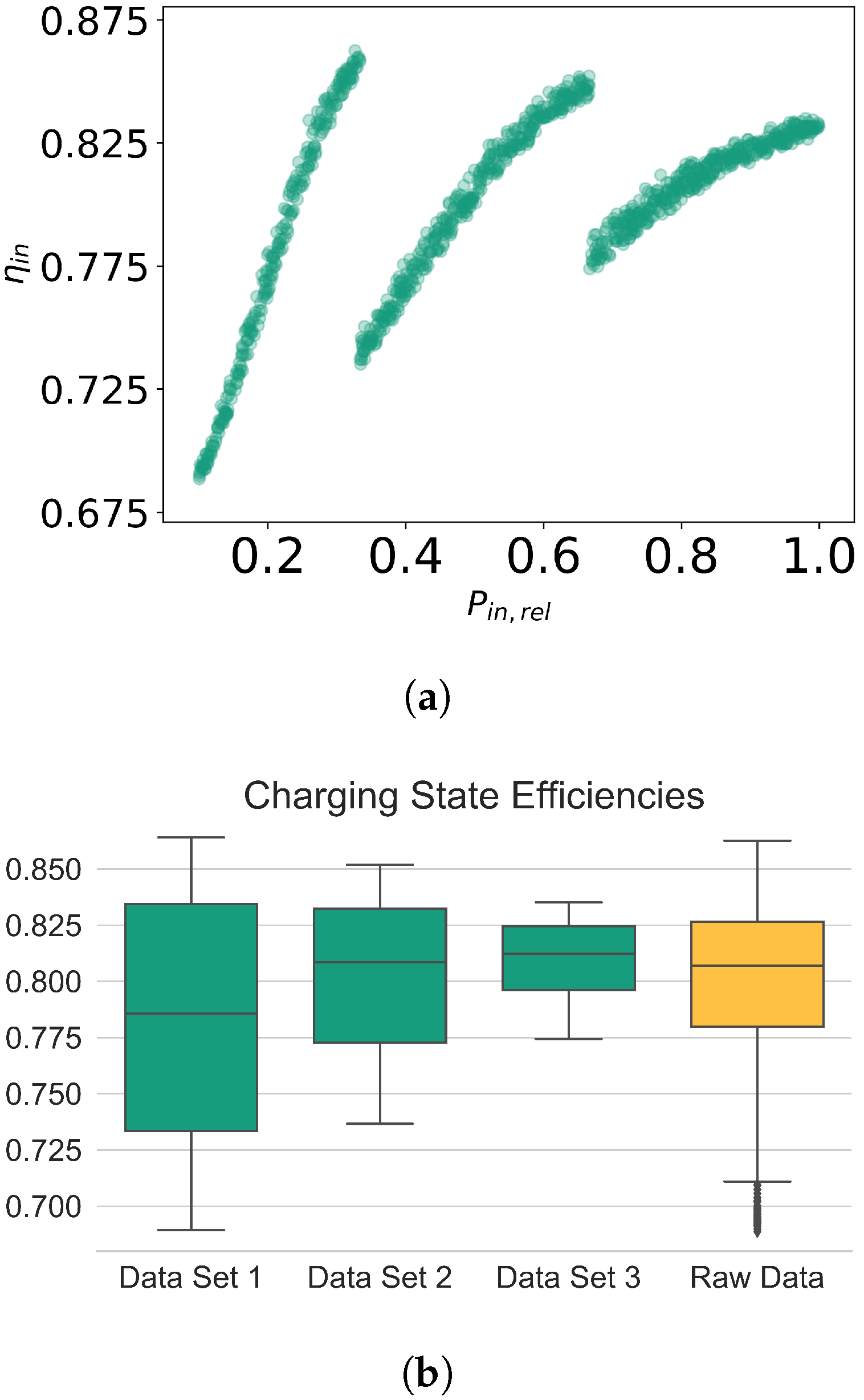Tool Chain for Deriving Consistent Storage Model Parameters for Optimization Models
Abstract
:1. Introduction
2. Materials and Methods
2.1. Step 1: Screening Parameters
2.2. Step 2: Dynamic Simulation
2.2.1. Requirements of a Storage Model
2.2.2. Design of Experiments
2.3. Step 3: Regression Analysis
2.4. Step 4: Refining Optimization Model
3. Results-Case Study
3.1. Step 1: Screening Influencing Factors
3.2. Step 2: Dynamic Simulation
3.2.1. Description of the PHES Model
3.2.2. Design of Experiments for PHES
3.3. Step 3: Regression Analysis
3.3.1. Data Analysis
- Sub-data set 1:
- Sub-data set 2:
- Sub-data set 3: .
3.3.2. Correlation Analysis
3.3.3. Assumption Analysis
3.3.4. Coefficient Analysis
3.3.5. Performance Analysis
3.4. Step 4: Refining Optimization Model
4. Discussion
Author Contributions
Funding
Data Availability Statement
Acknowledgments
Conflicts of Interest
Abbreviations
| I | Precipitation around the upper reservoir of a PHES system |
| IQR | Interquartile Range |
| OLS | Ordinary Least Squares |
| Net charged power in timestep t | |
| Net charged power at breakpoint n | |
| Net discharged power in timestep t | |
| Electrical charging power at breakpoint n | |
| Maximum electrical charging power | |
| Relative electrical charging power | |
| Electrical charging power in timestep t | |
| Electrical discharging power in timestep t | |
| Maximum electrical discharging power | |
| Electrical discharging power at breakpoint n | |
| PHES | Pumped hydroelectric energy storage |
| Coefficient of Determination | |
| Irradiance | |
| Difference between states of charge at timesteps t + 1 and t | |
| State of charge at the start of a simulation run | |
| Maximum state of charge | |
| State of charge in timestep t | |
| Ambient temperature of the upper reservoir of a PHES system | |
| Wind Speed around the upper reservoir of a PHES system | |
| Duration of one timestep | |
| Constant charging efficiency | |
| Constant discharging efficiency | |
| SOS2 variable | |
| Humidity around the upper reservoir of a PHES system |
Appendix A. Auxiliary Results for the Regression Analysis Example
Appendix A.1. Scatter Plots for Individual Influencing Parameters against Charging State Efficiency


Appendix A.2. Pearson Correlation Coefficient Matrices
| (a) . | ||||||||
| I | ||||||||
| −0.015 | 1 | |||||||
| 0.049 | 0.007 | 1 | ||||||
| 0.038 | −0.002 | 0.023 | 1 | |||||
| −0.001 | 0.03 | −0.002 | −0.524 | 1 | ||||
| −0.033 | −0.012 | 0.01 | −0.029 | 0.002 | 1 | |||
| I | −0.019 | 0.026 | 0.015 | −0.018 | 0.007 | 0.024 | 1 | |
| 0.012 | −0.02 | 0.018 | 0.03 | 0.001 | 0.048 | 0.016 | 1 | |
| 0.994 | −0.018 | 0.051 | 0.046 | −0.061 | −0.037 | −0.019 | 0.01 | |
| (b) . | ||||||||
| I | ||||||||
| 0.003 | 1 | |||||||
| −0.023 | 0.015 | 1 | ||||||
| 0.006 | 0.019 | −0.009 | 1 | |||||
| 0.034 | 0.04 | 0.009 | −0.514 | 1 | ||||
| −0.011 | 0.016 | 0.026 | 0.015 | −0.005 | 1 | |||
| I | 0.023 | 0.005 | 0 | −0.028 | 0.007 | −-0.064 | 1 | |
| −0.029 | 0.004 | 0.015 | 0 | −0.041 | 0.007 | −0.026 | 1 | |
| 0.984 | −0.03 | −0.022 | 0.016 | −0.072 | −0.009 | 0.028 | −0.024 | |
| (c) . | ||||||||
| I | ||||||||
| −0.034 | 1 | |||||||
| 0.004 | 0.023 | 1 | ||||||
| −0.016 | 0.02 | 0.021 | 1 | |||||
| −0.052 | 0.009 | 0.024 | −0.512 | 1 | ||||
| −0.021 | 0.01 | 0.036 | 0.024 | −0.04 | 1 | |||
| I | −0.019 | 0.003 | 0.013 | 0.016 | 0.037 | −0.028 | 1 | |
| 0.04 | 0.013 | 0.002 | −0.032 | 0.042 | −0.06 | −0.013 | 1 | |
| 0.968 | −0.044 | 0 | 0.019 | −0.231 | −0.009 | −0.027 | 0.025 | |
| (d) Raw charging state data. | ||||||||
| I | ||||||||
| −0.029 | 1 | |||||||
| −0.018 | −0.042 | 1 | ||||||
| −0.006 | −0.024 | −0.014 | 1 | |||||
| −0.004 | −0.028 | 0.013 | −0.492 | 1 | ||||
| −0.018 | −0.029 | 0.01 | −0.013 | 0.003 | 1 | |||
| I | −0.015 | −0.062 | 0.026 | −0.029 | 0.048 | −0.055 | 1 | |
| 0.02 | 0.002 | 0.017 | 0.025 | 0.009 | −0.042 | −0.021 | 1 | |
| 0.492 | −0.007 | −0.047 | −0.023 | −0.066 | −0.005 | 0.026 | −0.028 | |
Appendix A.3. Qualitative Analysis of the Coefficient Estimates
- Linearity
- Zero Expected Error
- Only Exogenous Influencing Parameters
- No Multicolinearity
- No Heteroscedasticity

- No Autocorrelation

References
- Washington Post Staff. The Glasgow climate pact, annotated. Washington Post, 13 November 2021. [Google Scholar]
- IEA-ETSAP. TIMES Version 4.6.1. 2022. Available online: https://zenodo.org/record/6412545#.Y9jNe63MJPY (accessed on 19 January 2022).
- DlR Institut für Vernetzte Energiesysteme. Energiesystemoptimierungsframework REMix. Available online: https://www.dlr.de/ve/desktopdefault.aspx/tabid-16034/25988_read-66795/ (accessed on 19 January 2022).
- Pfenninger, S.; Pickering, B.C. A multi-scale energy systems modelling framework. J. Open Source Softw. 2018, 3, 825. [Google Scholar] [CrossRef]
- Aghahosseini, A.; Bogdanov, D.; Ghorbani, N.; Breyer, C. Analysis of 100% renewable energy for Iran in 2030: Integrating solar PV, wind energy and storage. Int. J. Environ. Sci. Technol. 2018, 15, 17–36. [Google Scholar] [CrossRef]
- Doetsch, C.; Budt, M.; Wolf, D.; Kanngießer, A. Adiabates Niedertemperatur-Druckluftspeicherkraftwerk zur Unterstützung der Netzintegration von Windenergie; Fraunhofer UMSICHT: Oberhausen, Germany, 2012. [Google Scholar]
- Buffa, F.; Kemble, S.; Manfrida, G.; Milazzo, A. Exergy and Exergoeconomic Model of a Ground-Based CAES Plant for Peak-Load Energy Production. Energies 2013, 6, 1050–1067. [Google Scholar] [CrossRef]
- Budt, M. Thermodynamische Analyse Adiabater Druckluftenergiespeicher unter Berücksichtigung Feuchter Luft und Wassereinspritzung Mittels Dynamischer Simulation: Dissertation; Vol. Band 81, UMSICHT-Schriftenreihe; Karl Maria Laufen: Oberhausen, Germany, 2016. [Google Scholar]
- Guo, H.; Xu, Y.; Guo, C.; Zhang, Y.; Hou, H.; Chen, H. Off-design performance of CAES systems with low-temperature thermal storage under optimized operation strategy. J. Energy Storage 2019, 24, 100787. [Google Scholar] [CrossRef]
- Hadam, M. Thermodynamische Analyse Eines Modularen A-CAES Mit Umkehrbar Betreibbaren Turbo- und Kolbenmaschinen. Ph.D. Dissertation, Ruhr-Universität Bochum, Fakultät für Maschinenbau, Bochum, Germany, 2021. [Google Scholar]
- Mazloum, Y.; Sayah, H.; Nemer, M. Comparative Study of Various Constant-Pressure Compressed Air Energy Storage Systems Based on Energy and Exergy Analysis. J. Energy Resour. Technol. 2021, 143, 052001. [Google Scholar] [CrossRef]
- Mucci, S.; Bischi, A.; Briola, S.; Baccioli, A. Small-scale adiabatic compressed air energy storage: Control strategy analysis via dynamic modelling. Energy Convers. Manag. 2021, 243, 114358. [Google Scholar] [CrossRef]
- Schlachtberger, D.P.; Brown, T.; Schramm, S.; Greiner, M. The benefits of cooperation in a highly renewable European electricity network. Energy 2017, 134, 469–481. [Google Scholar] [CrossRef]
- Siebertz, K.; van Bebber, D.; Hochkirchen, T. Statistische Versuchsplanung; Springer: Berlin/Heidelberg, Germany, 2017. [Google Scholar] [CrossRef]
- Rönsch, S. Anlagenbilanzierung in der Energietechnik: Grundlagen, Gleichungen und Modelle für die Ingenieurpraxis; Springer Vieweg: Wiesbaden, Germany, 2015. [Google Scholar] [CrossRef]
- Casey, M. Vorlesung im Fach “Thermische Turbomaschinen”: Turbokompressoren und Ventilatoren (TKV); Vorlesung; Universität Stuttgart: Stuttgart, Germany, 2012. [Google Scholar]
- Traupel, W. Thermische Turbomaschinen, 4th ed.; Klassiker der Technik; Springer: Berlin, Germany, 2001. [Google Scholar]
- Lüdtke, K. Process Centrifugal Compressors: Basics, Function, Operation, Design, Application; Engineering Online Library; Springer: Berlin/Heidelberg, Germany, 2004. [Google Scholar]
- Dynardo GmbH. Methods for Multi-Disciplinary Optimization and Robustness Analysis; Dynardo GmbH: Weimar, Germany, 2017. [Google Scholar]
- Lumley, T.; Diehr, P.; Emerson, S.; Chen, L. The Importance of the Normality Assumption in Large Public Health Data Sets. Annu. Rev. Public Health 2002, 23, 151–169. [Google Scholar] [CrossRef] [PubMed]
- Maxwell, S.E. Sample Size and Multiple Regression Analysis. Psychol. Methods 2000, 5, 434–458. [Google Scholar] [CrossRef] [PubMed]
- Fahrmeir, L.; Heumann, C.; Künstler, R.; Pigeot, I.; Tutz, G. Statistik: Der Weg zur Datenanalyse, 8th ed.; Springer-Lehrbuch; Springer: Berlin/Heidelberg, Germany, 2016. [Google Scholar]
- James, G.; Witten, D.; Hastie, T.; Tibshirani, R. An Introduction to Statistical Learning: With Applications in R; Corrected at 8th Printing 2017 ed.; Springer Texts in Statistics; Springer: New York, NY, USA, 2017. [Google Scholar]
- Hayashi, F. Econometrics, 1st ed.; Princeton University Press: Princeton, NJ, USA, 2000; pp. 117–119. [Google Scholar]
- Backhaus, K.; Erichson, B.; Plinke, W.; Weiber, R. Multivariate Analysemethoden: Eine Anwendungsorientierte Einführung; Achte, Verbesserte Auflage ed.; Springer eBook Collection Business and Economics; Springer: Berlin/Heidelberg, Germany, 1996. [Google Scholar] [CrossRef]
- Gołebiewski, D.; Barszcz, T.; Skrodzka, W.; Wojnicki, I.; Bielecki, A. A New Approach to Risk Management in the Power Industry Based on Systems Theory. Energies 2022, 15, 9003. [Google Scholar] [CrossRef]
- Dassault Systèmes. DYMOLA Systems Engineering: Multi-Engineering-Modellierung und -Simulation auf Basis von Modelica und FMI; Dassault Systèmes: Velizy-Villacoublay, France, 2021. [Google Scholar]
- Modelon, A.B. Hydro Power Library: Modeling and Simulation of Hydro Power Plants for Performance Analysis, Optimization, and the Development and Verification of Plant Concepts and Control Strategies; Modelon AB: Lund, Sweden, 2018. [Google Scholar]
- Tuszynski, K.; Tuszynski, J.; Slättorp, K. HydroPlant-a Modelica Library for Dynamic Simulation of Hydro Power Plants; The Modelica Association, Modelica Conference: Vienna, Austria, 2006. [Google Scholar]
- Mousavi, N.; Kothapalli, G.; Habibi, D.; Khiadani, M.; Das, C. An improved mathematical model for a pumped hydro storage system considering electrical, mechanical, and hydraulic losses. Appl. Energy 2019, 247, 228–236. [Google Scholar] [CrossRef]
- Zsak, P.; Sigg, R.; Schaffner, C. Bestimmung von Wirkungsgraden bei Pumpspeicherung in Wasserkraftanlagen; Schweizerische Eidgenossenschaft, Bundesamt für Energie BFE Bern: Bern, Switzerland, 2008. [Google Scholar]
- Borghetti, A.; D’Ambrosio, C.; Lodi, A.; Martello, S. An MILP approach for short-term hydro scheduling and unit commitment with head-dependent reservoir. IEEE Trans. Power Syst. 2008, 23, 1115–1124. [Google Scholar] [CrossRef]
- Guisandez, I.; Pérez-Díaz, J.I. Mixed integer linear programming formulations for the hydro production function in a unit-based short-term scheduling problem. Int. J. Electr. Power Energy Syst. 2021, 128, 106747. [Google Scholar] [CrossRef]
- Chen, C.H.; Chen, N.; Luh, P.B. Head dependence of pump-storage-unit model applied to generation scheduling. IEEE Trans. Power Syst. 2016, 32, 2869–2877. [Google Scholar] [CrossRef]
- White, H. A Heteroskedasticity-Consistent Covariance Matrix Estimator and a Direct Test for Heteroskedasticity. Econometrica 1980, 48, 817–838. [Google Scholar] [CrossRef]




| Model Complexity Class | Model Application | Modelling Depth | Model Type |
|---|---|---|---|
| level 3 | technology/process development | very high | dynamic or static simulation of technology/process |
| level 2 | integration in local energy system | high | systemic bottom-up model |
| level 1 | integration in (trans)national energy system | medium | systemic bottom-up model |
| level 0 | integration in (trans)national energy system | low | systemic bottom-up model |
| level −1 | annual balance based integration in continental to global energy system models | very low | systemic top-down model |
| Parameter | Value |
|---|---|
| Nominal charging power [MW] | 159 |
| Nominal discharging power [MW] | 280 |
| Number of ternary machine sets [-] | 3 |
| pump/turbine head [m] | 435–483 |
| Upper reservoir volume [] | 30,000,000 |
| Nominal pump efficiency [-] | 0.89 |
| Nominal turbine efficiency [-] | 0.93 |
| motor and generator efficiency [-] | 0.96 |
| Factor | Minimum | Maximum |
|---|---|---|
| 0 | 0.99 | |
| 0.01 | 1.0 | |
| [K] | 253.15 | 313.15 |
| 0 | 100 | |
| [W m | 0 | 1000 |
| I [m s | 0 | |
| [m s | 0 | 14 |
| 0.1 | 0.334 | |
| 0.333 | 0.668 | |
| 0.668 | 1.0 |
| Factor/Response | Value 1 | Value 2 | Value 3 | ⋯ | Value 700 |
|---|---|---|---|---|---|
| 0 | 0.004 | 0.031 | ⋯ | 0.34 | |
| 0.384 | 0.38 | 0.297 | ⋯ | 0.478 | |
| [K] | 280.975 | 303.505 | 290.065 | ⋯ | 284.485 |
| 0.075 | 14.225 | 46.825 | ⋯ | 88.575 | |
| [W m | 17.85 | 874.65 | 1272.95 | ⋯ | 278.25 |
| I [m s | ⋯ | ||||
| [m s | 0.101 | 6.233 | 11.126 | ⋯ | 13.19 |
| 0.199 | 0.430 | 0.701 | ⋯ | 0.529 | |
| 0.78 | 0.789 | 0.794 | ⋯ | 0.8152 |
| (a) | |||
| 0.049 | 1 | ||
| −0.001 | −0.002 | 1 | |
| 0.994 | 0.051 | −0.061 | |
| (b) | |||
| 0.003 | 1 | ||
| 0.034 | 0.04 | 1 | |
| 0.984 | −0.03 | −0.072 | |
| (c) | |||
| −0.034 | 1 | ||
| −0.052 | 0.009 | 1 | |
| 0.968 | −0.044 | −0.231 | |
| (d) Raw Data (before partitioning) | |||
| 0.02 | 1 | ||
| −0.004 | 0.009 | 1 | |
| 0.492 | −0.028 | −0.066 | |
| (a) Statistical test results for and the approximative piecewise linear model (8). | ||
| Estimation Error | ||
| Intercept | 0.782|0.803|0.81 | || |
| 0.053|0.033|0.016 | || | |
| (b) Prediction errors used for 99% Prediction Intervals | ||
| Prediction Error | ||
| 0.013|0.014|0.01 | ||
| Regression Model (Level 1) | Constant Model (Level 0) | |
|---|---|---|
| 0.988|0.976|0.946 | 0.144 | |
| Mean Absolute Error | 0.005|0.005|0.003 | 0.031 |
| Max Absolute Error | 0.014|0.012|0.010 | 0.109 |
| n | ||
|---|---|---|
| 0 | 0.1002 | 0.6887 |
| 1 | 0.3333 | 0.8583 |
| 2 | 0.3338 | 0.7372 |
| 3 | 0.6663 | 0.8483 |
| 4 | 0.6668 | 0.7739 |
| 5 | 0.9993 | 0.8317 |
Disclaimer/Publisher’s Note: The statements, opinions and data contained in all publications are solely those of the individual author(s) and contributor(s) and not of MDPI and/or the editor(s). MDPI and/or the editor(s) disclaim responsibility for any injury to people or property resulting from any ideas, methods, instructions or products referred to in the content. |
© 2023 by the authors. Licensee MDPI, Basel, Switzerland. This article is an open access article distributed under the terms and conditions of the Creative Commons Attribution (CC BY) license (https://creativecommons.org/licenses/by/4.0/).
Share and Cite
Wode, K.; Strube, T.; Schischke, E.; Hadam, M.; Pabst, S.; Mittreiter, A. Tool Chain for Deriving Consistent Storage Model Parameters for Optimization Models. Energies 2023, 16, 1525. https://doi.org/10.3390/en16031525
Wode K, Strube T, Schischke E, Hadam M, Pabst S, Mittreiter A. Tool Chain for Deriving Consistent Storage Model Parameters for Optimization Models. Energies. 2023; 16(3):1525. https://doi.org/10.3390/en16031525
Chicago/Turabian StyleWode, Kristin, Tom Strube, Eva Schischke, Markus Hadam, Sarah Pabst, and Annedore Mittreiter. 2023. "Tool Chain for Deriving Consistent Storage Model Parameters for Optimization Models" Energies 16, no. 3: 1525. https://doi.org/10.3390/en16031525





